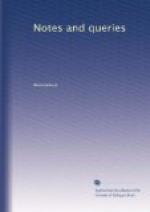“When they discovered how the sun by his heat and influence excited venereal love in creatures subserviant to his dominion, they then varied his sex, and painted him like a woman, because in them that passion is most impotent, and yet impetuous; on her head they placed a myrtle crown or garland to denote her dominion, and that love should be alwaies verdant as the myrtle; in one hand she supported the world, and in the other three golden apples, to represent that the world and its wealth are both sustained by love. The three golden apples signified the threefold beauty of the sun, exemplified in the morning, meridian, and evening; on her breast was lodged a burning torch, to insinuate to us the violence of the flame of love which scorches humane hearts.”—Philipot’s Brief and Historical Discourse of the Original and Growth of Heraldry, pp. 12, 13. London, 1672.
T.H. KERSLEY
King William’s College, Isle of Man.
Carpatio (Vol. ii., p. 247.).—Your Querist must be little versed in early Italian art, not to know that Vittore Carpaccio (such is the correct spelling) was one of the morning stars of the Venetian school; and his search must have been somewhat careless, as Carpaccio and his works are fully described in Kugler’s Handbook, p. 149., and in Lanzi. Some exquisite figures of his, of which Mrs. Jameson has given a St. Stephen in her Legendary Art, exist in the Brera at Milan. He is a painter not sufficiently known in England, but one whom it may be hoped the Arundel Society will introduce by their engravings. I cannot assist J.G.N. in explaining the subject of his engraving. May Cornubioe be by error for Cordubioe?
CLERICUS.
The Character “&".—This character your correspondent will at once see is only the Latin word “et”, written in a flourishing form; as we find it repeated in the abbreviation “&c.,” for “et cetera”. Its adoption as a contraction for the English word “and”, arose, no doubt, from the facility of its formation; and the name it acquired was “and-per se-and”, “and by itself and,” which is easily susceptible of the corruptions noticed by MR. LOWER.
[Greek: PHI].
Walrond Family (Vol. ii., p. 206.).—Burke, in his History of the Commoners, only gives the name of George, one of the sons of Colonel Humphry Walrond. He also states that the colonel married Elizabeth, daughter of Nathaniel Napier, Esq., of More Critchel. Now Colonel Walrond appears from his petition (Royalist Comp. Papers, State Paper Office) dated 12th February, 1648, addressed to the Commissioners for Compounding with Delinquents, to have had nine other children then living. He states: “Thus his eldest sonne George Walrond did absente himselfe for a short time from his father’s house, and went into the king’s army, where he unfortunately lost his right arme.




